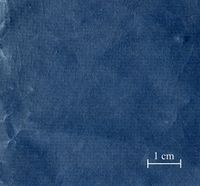Prussian Blue: Ukiyo-e colorant
Prussian blue ベロ藍 (bero-ai): The first modern synthetic pigment, Prussian blue was an accidental discovery made around 1704–6 by chemist Johann Jacob Diesbach with the help of alchemist Johann Conrad Dippel. Composed of ferric ferrocyanide, this synthetically produced pigment yields a vivid blue. Due to its high cost as an import from the West during the 1800s, it was used initially for paintings. By the end of the 1820s, this pigment was produced in China, thus making it affordable for use as a colorant for woodblock printing.
Prussian blue's bright, intense “true blue” color, fine particle size, and high tinting strength soon made it an indispensable addition to the printmaker’s palette, largely supplanting dayflower and indigo. This enabled an even, sharp printing as well as a greater range of tones especially when printing graduated color. It is thought that the introduction of this colorant into the printmaker’s palette stimulated Hokusai and Hiroshige to design the iconic landscape prints for which they are celebrated. Prussian blue is both lightfast and stable to moisture.
For additional information see: Prussian blue
Examples of Prussian blue in Ukiyo-e Prints

|

|

|

|

|
Analysis
Fiber optic reflectance spectroscopy (FORS) can easily identify the three blues: dayflower, indigo, and Prussian blue.
Interpretation
- The Prussian blue FORS spectrum exhibits a strong, broad absorption over the blue region resulting, for lack of a better term, a swoop or C on its back.
- As with all colors, the lighter intensity shows a more distinct curve. while the darker color can reach almost total absorption (see Eisen print #11.17884 example)
- The visual assessment of the blue is important because carbon black (soot) curves can look very similar to Prussian blue.
Images of Prussian blue
List of Prints
Below is a list of prints where Prussian blue was detected.
Pages in category "Prussian Blue: Ukiyo-e colorant"
The following 28 pages are in this category, out of 28 total.
E
H
- Hiroshige I, Enjoying the Cool of Evening on the Riverbed at Shijô, from the series Famous Views of Kyoto, 06.890
- Hiroshige I, Naitô Shinjuku, Yotsuya, from the series One Hundred Famous Views of Edo, 11.35823
- Hiroshige I, Pine of Success and Oumayagashi, Asakusa River, from the series One Hundred Famous Views of Edo, 11.17029
- Hiroshige I, The Yodo River, from the series Famous Views of Kyoto, 11.2111
- Hiroshige I/Hiroshige II, Ueno Yamashita, from the series One Hundred Famous Views of Edo, 11.35842
- Hokkei, Ômori, from the series Souvenirs of Enoshima, a Set of Sixteen, 11.19845
- Hokusai, Courtesan, Guest, and Pet Monkey, 21.9222
- Hokusai, Finest Confectionary: Descending Geese at the Sumida River, from the series Eight Views of Edo on paper snack bags, 21.10234
- Hokusai, Kajikazawa in Kai Province, from the series Thirty-six Views of Mount Fuji, 21.6773
- Hokusai, Kajikazawa in Kai Province, from the series Thirty-six Views of Mount Fuji, 21.6774
- Hokusai, Kajikazawa in Kai Province, from the series Thirty-six Views of Mount Fuji, 21.6775
- Hokusai, Kisen Hôshi, from an untitled series of Six Poetic Immortals formed by the characters for their names, 11.17543
- Hokusai, Twilight at Sensô-ji Temple, Asakusa, from the book Ehon Sumidagawa ryôgan ichiran, 21.9230
- Hokusai, Ushibori in Hitachi Province, from the series Thirty-six Views of Mount Fuji, 21.5363
- Hokusai, Ushibori in Hitachi Province, from the series Thirty-six Views of Mount Fuji, 21.5385
- Hokusai, Ushibori in Hitachi Province, from the series Thirty-six Views of Mount Fuji, 21.5386
K
- Kunisada, Komurasaki of the Kado-Tamaya, kamuro Kochô and Sayuri, from the series Comparison of Beauties of the Pleasure Quarters, 11.20991
- Kunisada, Poem by Ariwara no Narihira Ason: (Actor Ichikawa Danjûrô VIII as) Seigen, from the series Comparisons for Thirty-six Selected Poems, 11.42663
- Kuniyoshi, (Actor Ichikawa Ebizô V as) Inuyama Dôsetsu, from the series The Lives of Eight Brave and Loyal Dog Heroes, 11.28841
- Kuniyoshi, Actor Ichikawa Kodanji IV as the Ghost of Asakura Tôgo, 11.30460
- Kuniyoshi, Drying Board Suggesting Hiyodorigoe, from the series Women in Benkei-checked Fabrics, 11.36363
- Kuniyoshi, Hosokute: Horikoshi Dairyô, from the series Sixty-nine Stations of the Kisokaidô Road, 11.28766
- Kuniyoshi, Tsumagome: Abe no Yasuna and the Fox Kuzunoha, from the series Sixty-nine Stations of the Kisokaidô Road, 11.41803

















